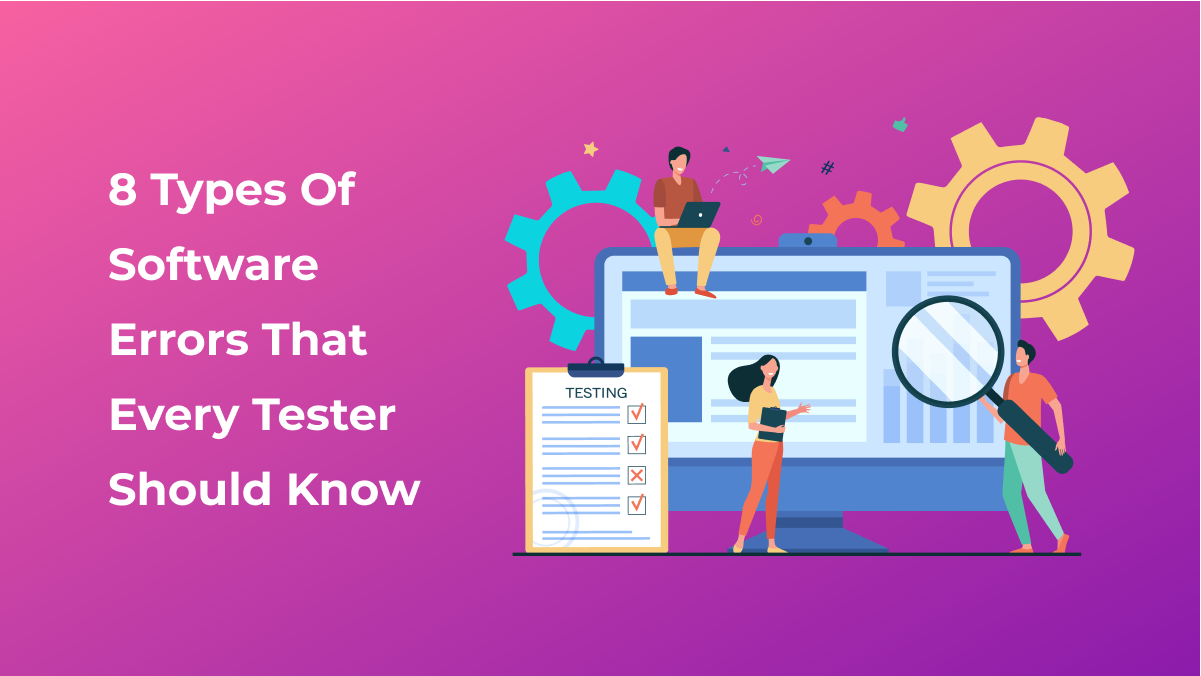Last updated on October 15th, 2022 at 07:18 pm
When you build software, you want it to run error-free. However, creating error-free software is not that easy as the developer has to write tremendous lines of code to meet the customer and business requirements.
Software errors and bugs are compelled to happen irrespective of how cautious the developer was in the development phase. As a tester, it is your responsibility to ensure that the software goes live without any bugs and errors.
Software errors can be prone to very general and relatively straightforward errors like an unclickable button to serious errors like values not got stored in the database. Both simple and major errors can damage a company’s reputation and also lead to financial losses. Hence, must be looked at seriously.
What are Software Errors and Bugs?
A software bug is a flaw, failure, or error in a program or a system that causes it to produce an unexpected or incorrect result or make it behave in unintended ways. A software error happens when there is a mistake in the source program, code, or operating system.
It is the joint responsibility of the developer and tester to deliver a quality code for the below reasons:
- Delivering quality code is the calling code of their profession and that is what is expected from them.
- Software with errors hinders work and productivity.
- Software errors in a live environment are costly, and hence testers must ensure all possible scenarios are tested.
Why is it Important to undertake Software & Bug Management?
The management of software bugs is important for a number of reasons. To begin with, most programmers and software developers for hire want to write quality code. As a professional, they live by that code. The business’ bottom line will suffer if the code is buggy, and it reflects poorly on the developers and their team. The second reason is that buggy code hinders productivity and is difficult to work with. A program’s effectiveness increases with the quality of the code it is written.
What are the Types of Software errors?
1. Functionality errors:
Functionality is the way the software is supposed to behave. The software can have a functionality error if something that was expected from it is not happening. For example, when the customer clicks on the Save button, all the information on the screen must be saved in the backend database but it’s not getting saved. When the customer logs back to his saved form, he has to reenter the name before submitting the form. It is a functionality error – small but an error that the developer should test.
2. Communication error:
Every user will be using your developed software for the first time. Hence, the software will be alien to them. Communication errors occur in communication from software to the end-user. It is missing information that the end-user should know to use the software. It is expected all required information should be available on the screen. For example, in one of the forms, there is a date field, but no communication is given about the date format – should the customer give DDMMYY, DDMMYYYY, MMDDYY, and so on. It is a communication error.
3. Missing command errors:
A software or functionality in the software should give the user all kinds of options while they work on it. Assume you created software that lets the manager create a new project for his team. He starts giving the details and after some time, realizes the project was already there, and there was no need to create it. He wants to CANCEL the project. However, you have only given him two options – Save and Submit. This is a missing command error. As a tester, you must take care of such errors while creating your test cases.
4. Syntactic Error:
These are common errors – they are not a show-stopper but leave an impression that the development team was not professional and was careless while developing. Syntactic errors are grammatically incorrect sentences or misspelled words. As a tester, you not only have to test the functionality but look at all the errors and confirmation messages that pop up while a customer uses the software. For example, you created a Cancel button that was incorporated after the tester reported a missing command error in the previous point. However, the button was labeled as CANCAL.
5. Error handling errors:
There are many messages that software gives to a user while they interact with it. These messages can also include errors. Any errors that occur while a user is using the software have to be handled clearly and in a meaningful way. If it is not done, it is referred to as an Error handling error. The tester must test and report all such errors. For example, the manager gave all the information to create a new project. When he tried to submit the project, he got an error message -‘ Something is wrong, the project cannot be submitted’.
After reading the message the manager will not be able to know the reason for this error? The tester must test all such scenarios. The error message here should have been – ‘Project hours is a mandatory field, please mention before submitting the project’.
6. Calculation errors:
All the errors we have discussed till now were mostly visible – the tester can look at them and log the errors. The tester must also look for calculation errors in the software. It can include bad logic, incorrect formula, coding error, data type mismatch, etc. For example, the team members are working on their project and have to update the hours completed on the project. The software has – total work hours, hours completed, and hours pending. It is expected that hours completed plus pending should equal total project hours. However, there is a mismatch in the values. Such errors will come under calculation errors.
7. Runtime errors:
The user encounters runtime errors when interacting with your program. A different configuration on the web server might be causing this error, even if the code works correctly on your device. A runtime error may have been caused by it interfering with the program in the wrong way.
It is particularly annoying when you encounter runtime errors because they directly impact your end-users. There are a lot of other errors that will occur while you are working on your code on your computer.
These types of errors can be minimized if you use frameworks and community-maintained code because they are used in multiple projects, so they have already encountered and resolved many problems.
8. Logic Errors:
There can be a lot of difficulty in locating logic errors. Despite the fact that everything appears to be working, you have just programmed the computer to do the wrong thing. Despite the fact that the program is technically correct, you won’t get the results you are expecting.
It would be logically incorrect for your code to return the oldest user when you needed the newest if you didn’t check the requirements beforehand.
A very good instance of Logic Error is of NASA. In 1999, A NASA spacecraft was lost because of miscalculations between American and English units. One way of coding the software did not work correctly.
Tests should be shown to the product owner or manager to verify that the logic you are about to write is correct.
Conclusion
When a developer creates software, there are high chances of having all the errors we have discussed above. Programming errors and software bugs are inevitable. You should try to identify them early, but you won’t always be perfect. When testing a program, you should break it in an unexpected way through the input of an unanticipated user. Following the approach, you will be able to test all the possible test scenarios. Hopefully, this guide has prepared you for the different types of errors in programming and made sense of some of the most common error messages for you.

Harikrishna Kundariya, a marketer, developer, IoT, ChatBot & Blockchain savvy, designer, co-founder, Director of eSparkBiz Technologies @Software Development Company. His 10+ experience enables him to provide digital solutions to new start-ups based on IoT and ChatBot.



